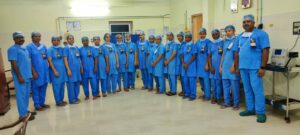The nurses' association told South First that over 15,000 members wore black badges when working at hospitals to register their protest.

Kerala nurses observe a black day with a black badge. (Supplied)
The United Nurses Association (UNA), the largest association of nurses based in Kerala, observed a “black day” on Thursday, 15 December, to protest against low wages and poor working conditions in the state.
The nurses demanded a minimum daily wage of ₹1,500, an assured staff-patient ratio, and an end to contractual employment so those on contracts are made permanent employees.
“For better wages, nurses are heading for a strike, enact latest minimum wage rules,” read the black banner the nurses wore to work on Thursday.
According to the union, over 15,000 of its members across the state went to work on Thursday wearing these badges.
A flex board erected in Thrissur city by the association read: “No increase in salary or revision of minimum wages, merely contract appointments and labour department made to a mannequin by hospital managements. The nursing community to begin widespread agitation across the state.”

Members of United Nurses Association, observing black day against low wages and poor working conditions. (Supplied)
UNA Treasurer Divya ES, an employee of a private hospital in Thrissur, told South First that the nurses were observing a black day merely to give a warning to the hospital authorities and the government.
“We are not holding a strike today. We are merely holding a state-wide black day just as a warning to the authorities,” she said.
“On 5 January, there will be a one-day strike in Thrissur, where minimum staff will work and the rest of us will march to the collectorate. If the authorities do not take action, we will go on a statewide strike,” added Divya.
She said most of the UNA’s organisational work starts in Thrissur city. Thus, they were starting their protest from Thrissur on 5 January.
According to the association, most private-hospital nurses in Kerala work under extremely difficult conditions and at starting wages that are in some instances even lower than those of unskilled labourers in the state.
In an earlier interview with South First, Dhanya, a nurse who works in a private hospital in Kannur, said the working hours were too long and the working conditions inadequate.
“In most private hospitals, there are no changing rooms or washrooms exclusively for the hospital staff. We are suffering here because a job is required to survive,” she told South First.
According to Dhanya, a fresh nurse receives no more than ₹7,000 as salary in some of the smaller hospitals, with annual increments as low as ₹100.
The Supreme Court in 2016 set up an expert committee after the Trained Nurses Association of India (TNAI) — one of the oldest and most prominent associations representing nurses — moved it seeking clear guidelines on their working conditions and pay scales in the private sector.
The Jagdish Prasad Committee collected data from various states and concluded in its report that the salaries and basic facilities provided to nurses in private hospitals and nursing homes were inadequate.
Recommending better working conditions for the nurses, it also laid down broad guidelines on their remunerations.
The committee recommended that salaries in hospitals with more than 200 beds should be on a par with those at state-run hospitals.
In hospitals with more than 100 beds, the salary should not be less than 90 percent of the state government salaries, while in hospitals with 50-100 beds, it should not be lower than 75 percent of the salary of the state government nurses.
The committee also said the salary should not be below ₹20,000 even in hospitals that have less than 50 beds.

Apr 24, 2024

Apr 24, 2024

Apr 24, 2024

Apr 24, 2024

Apr 24, 2024

Apr 24, 2024